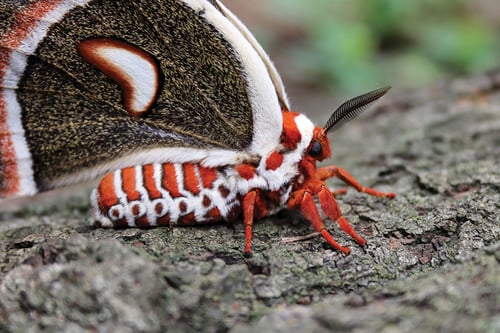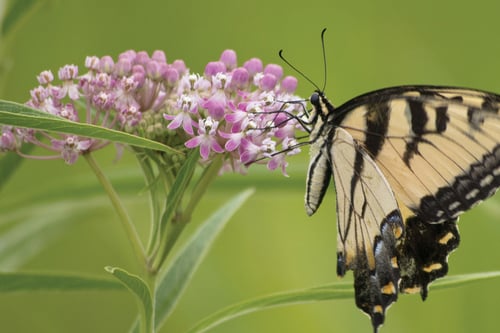Spring Issue 2022
From the President

Spring has sprung at the Forest Preserve District, and we’re offering a great lineup of programs to celebrate! To begin with, our popular native plant sale is back at Mayslake Peabody Estate, this time in-person and with a new ticketed presale event on May 12 hosted by the Friends of the Forest Preserve District. If you want a head start on your plant shopping, I recommend you sign up for the presale event at dupageforest.org/native-plant-sale.
Speaking of Mayslake, this year we’ll begin exterior renovations at historic Mayslake Hall, which will receive a major facelift. I’m also excited to share we’ve received a $750,000 grant from the Illinois Department of Natural Resources to help with this important renovation. The mansion, but not the preserve, will be closed to the public starting May 31, but we’ll have a full lineup of programs for the reopening in 2023.
This spring, work will also begin on two bridges at Hidden Lake. The bridge on the south side of Round Meadow Lake will be replaced, and the bridge across the East Branch DuPage River, which dates back to the 1870s, will be removed, refurbished off-site, and reinstalled. Both bridges should be in place by fall. During construction, there will not be access to Eagle Lake, but most of the Round Meadow Lake Trail will be accessible.
Throughout DuPage, residents will see projects and restorations, and I ask for your understanding and patience as we continue to reinvest for future generations. Many of these projects take time, which we understand can affect visitors, but our team will work hard to limit disturbances and minimize negative effects wherever possible. I hope you’ll agree the positive long-term benefits will far outweigh any temporary inconveniences.
As president, I’m always available to answer any questions or concerns, and you can reach me at dhebreard@dupageforest.org.
I’ll see you on the trails!

Daniel Hebreard
President, Forest Preserve District of DuPage County
News & Notes
Mayslake Hall to Temporarily Close for Major Exterior Restoration

Historic Mayslake Hall in Oak Brook will close for up to a year beginning May 31 for a major exterior improvement project. The certified master plan project will repair structural deficiencies and other problems with the roof, masonry, wood, stucco, windows, doors, and foundation. It will also improve drainage and accessibility.
A $750,000 capital grant from the Public Museum Capital Grants Program, Illinois Department of Natural Resources, Illinois State Museum will help pay for the renovations. The Tudor Revival-style mansion is on the National Register of Historic Places and is one of the last remaining examples of the country estates that dotted DuPage between 1880 and 1924.
Although the 100-year-old mansion will temporarily close starting May 31, the surrounding forest preserve will remain open. First Folio Theatre will have a 2022 – 2023 season at the estate but one built around the construction schedule.
The Forest Preserve District is already planning new exhibits and programs for Mayslake Hall’s reopening in 2023, including an exhibit of Joel Sheesley’s paintings of the West Branch DuPage River.
Collections Corner

Over an extensive history of habitation, animals and humans have left traces of their existence in forest preserves across the county, and the Forest Preserve District is partnering with institutions, including the Illinois State Archaeological Survey, to advance the management of these significant finds.
An anthropology major with North Central College is inventorying the District’s collection at the college’s archaeology lab. When completed, the catalog will allow the District to better track and share artifacts with researchers for display or study, such as pieces currently on display through June 5 as part of the People of the Prairie: 12,000 Years in DuPage County exhibit at the Elmhurst History Museum.
Although artifact loans are a great start, future elements may include online exhibits and hands-on experiences to further connect DuPage residents to the land and its rich past.
Live and on Demand

Can’t make it to a board meeting? Find schedules and agendas and watch it live or on demand under “Our Board.” You can also link directly to live streaming video from the Forest Preserve District’s Facebook page at facebook.com/dupageforest.
Commission meetings and planning sessions are open to the public and held at Forest Preserve District headquarters at 3S580 Naperville Road in Wheaton. Normally, commission meetings are at 8 a.m. on the first and third Tuesdays of the month; planning sessions, 8 a.m. on the second and fourth Tuesdays. At both, the board hears public comments and staff reports, discusses business, and votes on agenda items.
Visitor Services Saturday Phone Hours
This summer, the Forest Preserve District’s Visitor Services office is making it easier on Saturdays to get answers to questions about permits, reservations, programs, boat rentals, and more.
Our Visitor Services team will be available for phone calls, emails, and online chats Saturdays June – August (except July 2) 9 a.m. – 2 p.m. (The office is not open to walk-in visitors during these Saturdays.) To reach the office during these hours, call
630-933-7248, email permits@dupageforest.org, or chat online at dupageforest.org.
Floods Wash Out Bridge at Waterfall Glen
On Feb. 17 at Waterfall Glen, flood waters washed out the pedestrian bridge over Sawmill Creek on the main loop trail between mile markers 5.5 and 6. While the Forest Preserve District works on plans to construct a new bridge, preserve visitors should avoid that stretch of the trail. For updates, visit dupageforest.org and click on “News” and “Upcoming Projects.”
New Accessible Kayak Launch at Blackwell

In winter 2021, the Forest Preserve District installed an ADA-accessible launch for kayaks and canoes at Silver Lake at Blackwell. The launch features a boat slip and a transfer platform with handrails, which will allow individuals of all abilities to load and launch independently. An accessible path from the parking lot and a concrete sidewalk ramp to the launch area are also new additions to the site.
The launch, the first of its kind at a DuPage forest preserve, is also available to visitors who wish to rent kayaks on Silver Lake.
The Friends of the Forest Preserve District provided $15,000 in donations toward the $75,650 project. The Forest Preserve District plans to open the launch April 2 and to host a ribbon-cutting ceremony April 23.
District Earns AAA Rating from S&P

The Forest Preserve District earned a AAA rating from Standard & Poor’s Global Rating for its series 2022 general obligation limited-tax bonds, which will be used to pay for certified master plan projects without raising debt-servicing costs or increasing taxes.
S&P also affirmed its AAA rating on the Forest Preserve District’s general obligation debt outstanding. This is the highest rating of credit worthiness attainable by any agency in the financial industry. The District has maintained this rating since 1997.
The ratings report notes many of the strengths of the District and states that the Forest Preserve District has “an extremely strong and stable credit supported by very strong management.” The full report can be found online.
Keep in Touch Between Issues
Want to read the latest in between your quarterly issues of the Conservationist? Then subscribe to our monthly “Navigator” e-newsletter! Sign up online and select “Navigator.”
If You Care, Leave Them There

It’s baby animal season, and Willowbrook Wildlife Center is reminding residents it’s normal for wild animals to leave their young alone for several hours at a time. Human intervention may be helpful, though, if an animal is injured or truly abandoned.
If you have concerns about a wild animal, contact Willowbrook at 630-942-6200 or willowbrook@dupageforest.org for guidance. Calls are answered daily, and after-hours recordings provide general information.
Many Thanks

The Forest Preserve District thanks the donors who contributed to its efforts Nov. 1 – Dec. 31, 2021. To learn how your financial support can benefit the District, visit dupageforest.org/friends. To give to the 501(c)(3) nonprofit Friends of the Forest Preserve District, visit dupageforestgiving.org/donate.
Gifts of Note
Joel Herning
$1,000 — Willowbrook Wildlife Center
DuPage Birding Club
$500 — Willowbrook Wildlife Center
Howard Goldstein and Margaret McGrath
$500 — Willowbrook Wildlife Center
Gifts of Note to the Friends of the Forest Preserve District
Ellen Alekno Wier
$8,000 – Willowbrook Wildlife Center
Anonymous (2)
$5,500 – Greatest needs
G. Carl Ball Family Foundation
$5,000 – Greatest needs
Larry Larson
$3,000 – Greatest needs, Adopt a Blanding’s Turtle, Volunteer Services
Mary J. Demmon Private Foundation
$3,000 – Danada Equestrian Center
Ranch Spur Charitable Trust
$2,500 – Greatest needs
Harold and Mary Bamford III
$2,000 – Willowbrook Wildlife Center
Elaine Novak Jans
$2,000 – Greatest needs
Michael and Diane Webb
$2,000 – Mayslake Peabody Estate restoration, Willowbrook Wildlife Center
Seth Becker and Helen Nam
$1,605 – Willowbrook Wildlife Center
Carol Hughes
$1,500 – Greatest needs
David Light
$1500 – Greatest needs, Kline Creek Farm
Susan Carr
$1,000 – Willowbrook Wildlife Center
James and Valerie Carroll
$1,000 – Willowbrook Wildlife Center
David & Claudia D’Hooge
$1,000 – Willowbrook Wildlife Center
Domtar Paper Company
$1,000 – Greatest needs
David Ginther
$1,000 – Willowbrook Wildlife Center
Judith Grey
$1000 – Adopt a Blanding’s Turtle, Green Energy Endowment, Natural Resources habitat restoration
Mary Ann Mahoney
$1,000 – Greatest needs
Carol McGee
$1,000 – Willowbrook Wildlife Center
Coral Baran
$500 – Willowbrook Wildlife Center
Michael Firman and Marilyn Schweitzer
$500 – Willowbrook Wildlife Center, Adopt a Blanding’s Turtle
Corryn Greenwood
$500 – Willowbrook Wildlife Center
Chaney Kalinich
$500 – Willowbrook Wildlife Center in memory of Daniel Motel
Denise Kennedy
$500 – Preserve improvements in memory of James Kennedy
Tim Letizia
$500 – Greatest needs
Francine Manilow
$500 – Preserve improvements
Elaine McCluskey
$500 – Greatest needs
Carol O’Neal
$500 – Willowbrook Wildlife Center
John and Gloria Page
$500 – Willowbrook Wildlife Center
Pat Pappas
$500 – Fullersburg Woods
Edmond Pereira
$500 – Willowbrook Wildlife Center
Allison Riley
$500 – Greatest needs
John Schofield
$500 – Greatest needs
Alex Schut
$600 – Greatest needs
John and Marion Tableriou
$500 – Greatest needs
Heather and Mark Yeager
$500 – Willowbrook Wildlife Center
Douglas Zimmer
$500 – Mayslake Peabody Estate
Planting for Small Spaces
As someone who loves to plant flowers and grasses but has little backyard space, I’ve learned to become a fan of container gardening. It might seem that these constraints would rule out enjoying the benefits of native perennials, but it’s quite the contrary.
Native plants are one of the best things for any garden, even one in a container. They require fewer herbicides and pesticides than nonnatives, making them easier to maintain. They’re cost-effective, too, because they return year after year, a fact that offsets any extra investments made up front. Aesthetically, they create a beautiful homage to the bountiful prairie lands that once dominated this region.
When considering this type of garden, the container is the most important part. Fortunately, you don’t have to break the bank or reinvent the wheel to find the right one; you just need to keep two things in mind. First, any pot you use should have drainage holes, be deep enough for long native roots, and be wide enough for growth. If a pot’s deep and wide enough but lacks drainage holes, simply add a few yourself. You can also promote healthy drainage by placing rocks at the bottom so the roots don’t get soggy in standing water.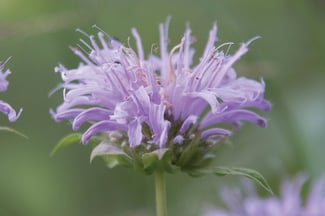
Second, give thought to the material of the container, especially if you plan on moving it. Wood or porous clay pots can be attractive, but metal or plastic ones are usually more durable and weigh much less. To further reduce weight, you can displace some of the soil with artificial fillers, such as cut-up pool noodles or empty water bottles. Fill the bottom quarter of your container with these items and then lay a sheet of landscaping cloth on top before adding the soil. And don’t be afraid to get creative. Last spring, I turned a 30-year-old wheelbarrow into a bed for shallow natives!
Selecting what soils or other elements you’ll use to fill your pot is next. Check your plant label for soil needs. Soil compacts over time so a mixture is a good option for container planting. For instance, if a plant requires sandy soil, add coarse builder’s sand into the mix. In any case, avoid peat; it breaks down into carbon dioxide and water, not ideal conditions for plants.
And a word about fertilizer. Fertilizers aren’t always necessary with native plants but can be helpful if natives are mixed in with annuals. Too much fertilizer, though, can kill a plant.
When it’s time to water, you don’t need a set schedule. Rain will take care of a lot of your needs, but plants do lose moisture on windy or hot days. To check the moisture level, stick a finger about 2 inches into the soil. If it’s dry, you may need to water, but make sure you water the container thoroughly so all the plants get an even amount. For the best outcome, combine plants that like similar moisture levels. If you notice the leaves begin to droop or yellow, it’s a sign the roots may be rotting and you’re likely overwatering.
When it’s time to start selecting plants, you’ll need to assess how much light your garden will receive. Fortunately, an inexpensive light meter can help. As with moisture, it’s best to calculate how much sun a spot will receive and then use plants with similar light requirements.
You’ll also need to plan around the height and spread of plants when they’re mature. After all, it takes about three years for plants to reach their maximum size. In addition to envisioning how plants will fill in, don’t forget vertical growth. In some cases you may want to consider investing in a trellis or lattice to support taller individuals.
One way to select natives is to use the matrix planting technique: Plant a sprawling ground cover, and pepper in some taller plants to add dimension. At the center or “back” of the pot, bunch in some native grasses to add texture and height.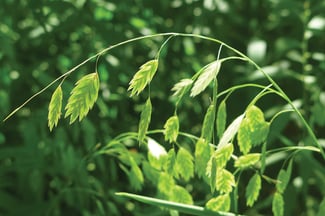
Another planting technique is to incorporate a “spiller,” a “filler,” and a “thriller.” Low-growing spillers drape over the side of the pot. River oats is an attractive spiller because its seedpods bow down in delicate arches. Fillers take up the space between spillers and thrillers. They’re low to medium growers that form nice clusters of vegetation. Wild geranium is an effective filler because it has attractive foliage as well as soft blossoms.
Finally, thrillers are the exclamation points or statement pieces. Wild bergamot is a thriller with tall stalks and bright blooms. (Its leaves also have a pleasing basil scent.) Thrillers can stand alone, but they really shine when accompanied by fillers and spillers.
Regardless of which design technique you use, pay attention to plants’ bloom times. Try to stagger them so you have color year-round, even if it’s simply brown or red woody vegetation in winter. When winter arrives, though, you may want to bring plants indoors to prolong the life of your container. Deadheading flowers in February can also help.
There are many options for growing natives no matter the size of the space. Whatever container you choose, if you use native plants you’ll not only enjoy a diverse array of colors and textures but also provide islands of habitat for local wildlife. So let’s get planting!
Which Insect Is It?
Picture it. It’s a beautiful summer day. You’re on a DuPage forest preserve trail, and out of the corner of your eye you see...something. Something small, something moving. Some kind of insect. Is it a bee, wasp, or fly? A beetle, butterfly, or moth? Insects are the most abundant and diverse group of animals on the planet (there are 30 million species worldwide), so figuring out who’s who can be a task, but by looking at a few features, you’ll find insect identification isn’t as hard as it seems.
First, are you looking at an arthropod? Does it have distinct legs and a hard outer covering? If so, it’s an arthropod. Not all arthropods are insects, though. Does it have wings? Then it’s an insect. Insects are the only arthropods that have them. Spiders, daddy longlegs, centipedes, crustaceans, and other arthropods don’t have wings, so they’re not insects. If you still aren’t sure, look at the number of body segments and legs.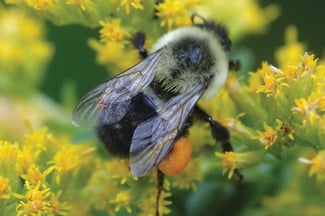
Insects always come in threes: three body segments and three pairs of legs. Other arthropods typically have fewer body segments but more legs. Spiders have four pairs of legs, many crustaceans have five, and centipedes, well, they have a bunch.
So now that you know you’re looking at an insect, it’s time to look at divisions of insects, called orders, and who belongs to each. To date, there are 29 different orders, which means it would be difficult to describe them all here, but we can look at some general features of a few that live in DuPage.
One of the most recognizable orders is Lepidoptera, the butterflies and moths. These are insects with large fully-colored wings covered by “scales,” which protect the wings and are unique to this order. Other insects may have pigmentation on their wings or scales on other parts of their bodies, but wings fully covered by scales tells you it’s a Lepidoptera. But how can you tell the difference between butterflies and moths? Both can be colorful or drab, and both are active during the day, but butterfly antennae are thin with small bulbs on the ends; moths’ are feathery or serrated.
Another order is Hymenoptera, which includes ants, bees, and wasps, most with pinched waists that give them an hourglass shape, although this can be difficult to see in bees, which are stocky. Two examples of Hymenoptera are the common eastern bumblebee, which like other bumblebees is quite stout and covered with hairs, and the paper wasp, which, like most wasps, is slender, smooth, and shiny.
Of all the insect orders, Coleoptera, or beetles, are the most diverse. Beetle features are harder to see but make them easy to ID once you do. First, beetles have mouthparts called “mandibles” for chewing and not for stabbing (like mosquitoes) or sucking (like butterflies). Their first pair of wings are also modified into hard outer coverings, called “elytra,” that fully cover their soft flying wings. Common coleopterans include fireflies, ladybugs, and June bugs. You may also spot the distinctive (and fast) metallic green six-spotted tiger beetle on sunny forest preserve trails.
Now onto the order Orthoptera, the grasshoppers, crickets, and katydids, most with large well-developed hind legs for jumping. Grasshoppers, usually green or brown with short, stubby antennae, make clicking sounds with their wings as they spring from place to place. Crickets are black or brown and smaller with long, slender antennae. They produce a chirping sound with their legs. And if you see something big and green with long antennae (or hear a staccato “katy-did-katy-didn’t” call at night), that’s a katydid!
Both members of the Odonata order, dragonflies and damselflies, are often found near water (they spend most of their larval stages developing underwater), and both have large well-developed eyes and four distinct flying wings. But there’s one sure way to tell them apart. Dragonflies at rest hold their wings straight out from their bodies; damselflies usually fold their wings over their bodies like butterflies.
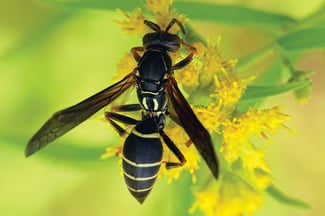 Finally, let’s wrap up our short selection of insects by looking at the “true flies” of the order Diptera. True flies are unique because they have only one set of flying wings; the other pair is modified into tiny clubs that act as stabilizers. Like Odonata, true flies have large, well-developed eyes that take up much of their heads. One of the most well-known is the ubiquitous housefly, but if you spend time outside you’ve likely met its biting cousins, the horsefly and deer fly. Females of the latter two have sharp stabbing mouthparts like those of mosquitoes, which are another type of true fly. (Crane flies, large true flies with long, thin legs, are often mistaken for mosquitoes, but crane flies do not bite.) To make things more interesting, there are also syrphid flies, or hoverflies, many of which have yellow and brown stripes, which make them look like bees. However, syrphid flies have one set of flying wings and the stereotypical large eyes of true flies, and none of them sting.
Finally, let’s wrap up our short selection of insects by looking at the “true flies” of the order Diptera. True flies are unique because they have only one set of flying wings; the other pair is modified into tiny clubs that act as stabilizers. Like Odonata, true flies have large, well-developed eyes that take up much of their heads. One of the most well-known is the ubiquitous housefly, but if you spend time outside you’ve likely met its biting cousins, the horsefly and deer fly. Females of the latter two have sharp stabbing mouthparts like those of mosquitoes, which are another type of true fly. (Crane flies, large true flies with long, thin legs, are often mistaken for mosquitoes, but crane flies do not bite.) To make things more interesting, there are also syrphid flies, or hoverflies, many of which have yellow and brown stripes, which make them look like bees. However, syrphid flies have one set of flying wings and the stereotypical large eyes of true flies, and none of them sting.
There’s a lot to examine in the insect world, but if you grab a good field guide, focus on key features, and learn a few different ones each year, you’ll be on your way to identifying “which insect is it” in DuPage forest preserves in no time!
You Can’t Judge a Lepidoptera by Its Cover
You may at one point have heard that you can tell butterflies from moths by their colors, butterflies being more vivid than their drab nighttime cousins. But some moths, like the cecropia silk moth at the top, are just as colorful as any butterfly. So how can you tell who’s who? One way is to look at the antennae. In most cases butterflies (including the eastern tiger swallowtail at the bottom) have antennae with clubbed tips; moths’ antennae are feathery.
